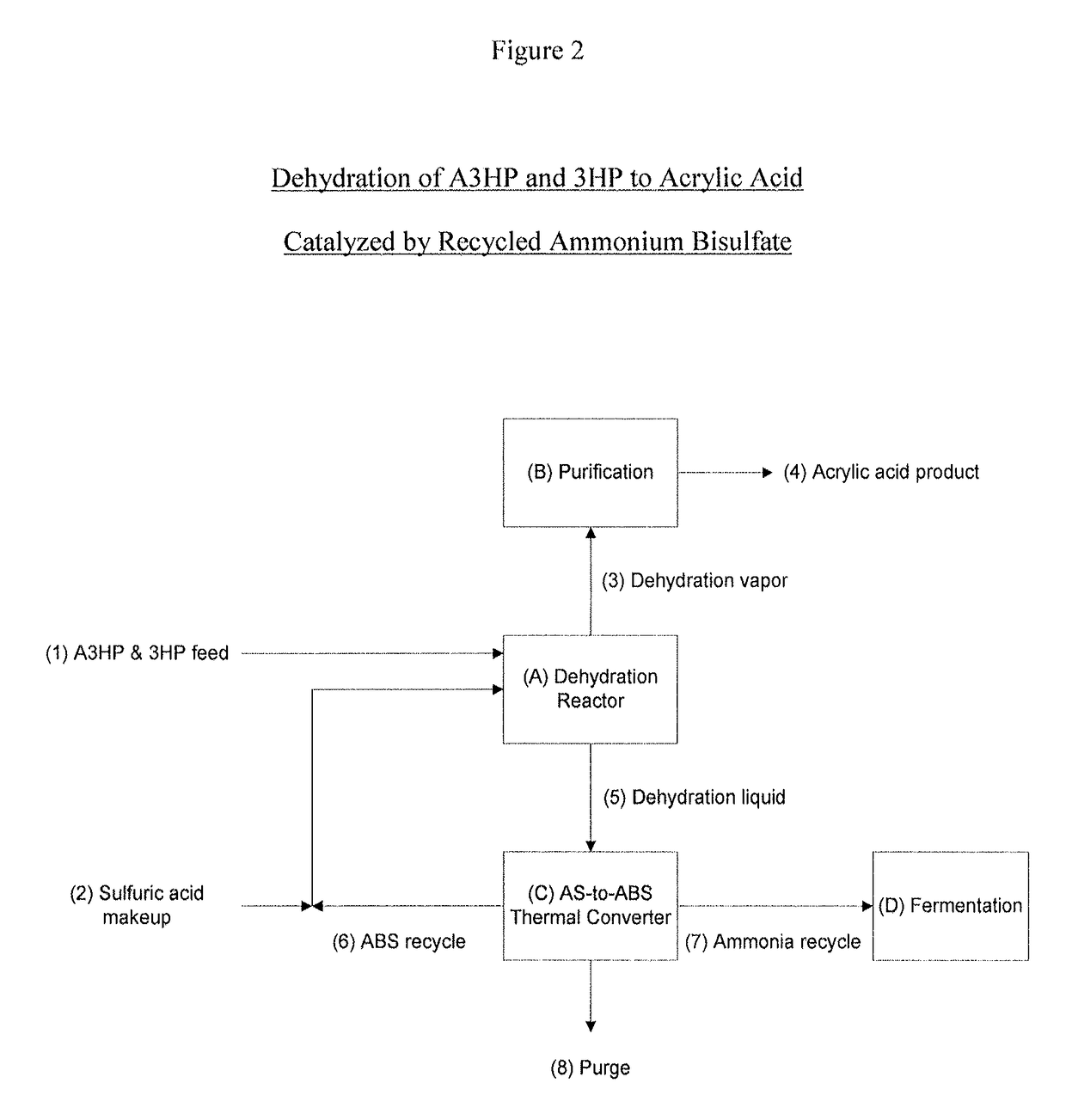Ammonium bisulfate catalyzed dehydration of beta-hydroxy acids
a technology of ammonium bisulfate and beta-hydroxy acids, which is applied in the preparation of carboxylic compounds, physical/chemical process catalysts, organic chemistry, etc., can solve the problems of difficult discharging of reactor bottoms, large capital investment, and inability to recover ammonia in the bottom stream of the process
- Summary
- Abstract
- Description
- Claims
- Application Information
AI Technical Summary
Benefits of technology
Problems solved by technology
Method used
Image
Examples
example 1
ABS Catalyzed Dehydration of Bio3HP at 1-Liter Scale
[0059]Bio-3HP broth produced by fermentation using a genetically-engineered strain of E. coli is centrifuged to remove cells and is concentrated on a rotary evaporator to produce a clarified aqueous concentrate containing 30 wt % 3HP. The clarified concentrate is diluted and the pH is adjusted to pH 2 with concentrated sulfuric acid, resulting in a dehydration feed concentration of 10.6 wt % 3HP. At pH 2, any ammonium ion present in the initial concentrate is converted to ABS.
[0060]A one-liter (1 L) glass reactor equipped with an electric heating mantle is charged with 300 grams (g) solid ABS (obtained from Sigma Aldrich, catalog number 09848) and 50 g of deionized (DI) water. The ABS solution is heated to 160° C. and overhead stirring is maintained to keep the solution uniform during heat-up and throughout the reaction. The bio-3HP feed is pumped at 1 milliliter per minute (mL / min) by a Watson Marlow 32 revolutions per minute (rpm...
examples 2a and 2b
Effect of Temperature on ABS-Catalyzed Dehydration of Bio3HP at 1-L Scale
[0061]Bio-3HP fermented by a genetically-engineered strain of E. coli is centrifuged to remove cells and is concentrated on a rotary evaporator to produce a clarified aqueous concentrate. The feed for both experiments are adjusted to pH 2 with concentrated sulfuric acid and had a final concentration of 22 wt % 3HP. A 1 L glass reactor equipped with an electric heating mantle is charged with 300 g solid ammonium bisulfate and 50 g of DI water. An ABS solution is heated to 165° C. and 180° C. for each of Examples 2A and 2B and overhead stirring is maintained to keep the solutions uniform during heating and throughout the reaction. The bio-3HP concentrate is pumped at 1 mL / min by a Watson-Marlow 32 rpm peristaltic pump operating at 1% power setting onto the surface of the agitated liquid ABS catalyst. After completion of 3HP feeding, 100 mL of DI water is similarly fed to the reactor at a rate of 1 mL / min. At a fe...
example 3
ABS-Catalyzed Dehydration of AOPA
[0062]AOPA feed is generated from an acrylic acid distillation column bottoms sample. This sample contains primarily AOPA with residual AA, and is diluted to approximately 15% sample in water. The feed to the dehydration reactor consists of 6.1% AA and 9.3% AOPA, the remaining 84.6% is deionized (DI) water. A one-liter glass reactor equipped with an electric heating mantle is charged with 300 grams (g) of solid ammonium bisulfate (obtained from Sigma Aldrich, catalog number 09848) and 50 g of DI water. The ABS solution is heated to 165° C. and overhead stirring is maintained to keep the solution uniform during heating and throughout the reaction. The diluted AOPA is pumped at one milliliter per minute (1 mL / min) by a Watson-Marlow 32 revolutions per minute (rpm) peristaltic pump operating at a 1% power setting onto the surface of the agitated liquid ABS catalyst. After completion of 3HP feeding, 100 mL of DI water is similarly fed to the reactor at a...
PUM
| Property | Measurement | Unit |
|---|---|---|
| temperature | aaaaa | aaaaa |
| temperature | aaaaa | aaaaa |
| temperature | aaaaa | aaaaa |
Abstract
Description
Claims
Application Information
 Login to View More
Login to View More - R&D
- Intellectual Property
- Life Sciences
- Materials
- Tech Scout
- Unparalleled Data Quality
- Higher Quality Content
- 60% Fewer Hallucinations
Browse by: Latest US Patents, China's latest patents, Technical Efficacy Thesaurus, Application Domain, Technology Topic, Popular Technical Reports.
© 2025 PatSnap. All rights reserved.Legal|Privacy policy|Modern Slavery Act Transparency Statement|Sitemap|About US| Contact US: help@patsnap.com



